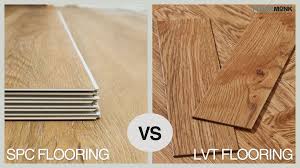The primary distinction between SPC (Stone Plastic Composite) and LVT (Luxury Vinyl Tile/Plank) lies in their core composition, which impacts their flexibility, durability, and ideal applications.
Why LVT is Softer Than SPC
The key to LVT’s softer, more flexible nature compared to SPC is its core material.
- LVT (Luxury Vinyl Tile/Plank): Traditional LVT has a flexible PVC (polyvinyl chloride) core. This pure vinyl construction allows LVT planks to bend and conform more easily. This flexibility results in a slightly softer feel underfoot and can be more forgiving on minor subfloor imperfections.
- SPC (Stone Plastic Composite): SPC, on the other hand, features a rigid core composed of approximately 60-80% natural limestone powder, PVC, and stabilizers. The high concentration of stone powder makes the core extremely dense and stiff, significantly reducing its flexibility. This rigidity is what gives SPC its superior dent resistance and dimensional stability.
Raw Materials
- LVT:
- Core: Primarily virgin PVC or recycled PVC.
- Layers: Typically consists of a PVC backing layer, the PVC core, a print film layer (for the visual design), and a wear layer (for protection).
- SPC:
- Core: A composite of natural limestone powder (usually 60-80%), PVC resin, and stabilizers.
- Layers: Usually includes an EVA or IXPE foam underlayment (often pre-attached), the rigid SPC core, a print film, and a wear layer.
Manufacturing Process
- LVT: The manufacturing process for LVT typically involves hot-pressing multiple layers of PVC and the print film together. The core is extruded, and then the other layers are fused onto it under heat and pressure.
- SPC: SPC’s manufacturing process is more complex due to its rigid core. The stone-plastic composite core is extruded first, creating a very dense and stable base. Then, the other layers (print film, wear layer) are laminated or hot-pressed onto this rigid core. The integrated underlayment is often added during this process or supplied as a separate roll.
Use Cases (Application Scenarios)
- LVT:
- Residential: Excellent for general residential use, offering comfort and a wide range of aesthetic options.
- Light Commercial: Suitable for areas with moderate foot traffic like small offices, boutiques, or salons.
- Moisture-Prone Areas: Many LVT products are water-resistant, making them suitable for bathrooms and kitchens, but not always fully waterproof at the seams unless specifically designed as such.
- Areas Requiring Softer Feel: Good for spaces where a slightly softer underfoot feel is desired.
- SPC:
- High-Traffic Commercial: Ideal for busy commercial spaces like retail stores, restaurants, hospitals, and offices due to its extreme durability and dent resistance.
- Residential (High Durability Needs): Perfect for homes with pets, children, or heavy furniture where resistance to dents and scratches is crucial.
- Areas with Temperature Fluctuations: Its rigid core makes it highly stable and resistant to expansion/contraction, making it suitable for sunrooms, basements, or areas with inconsistent temperatures.
- Waterproof Applications: Nearly all SPC products are 100% waterproof, making them perfect for bathrooms, kitchens, and basements where water exposure is a concern.
- Uneven Subfloors: While a level subfloor is always recommended, SPC’s rigidity allows it to bridge minor subfloor imperfections better than LVT, reducing telegraphing.
Maintenance
Both LVT and SPC are relatively low-maintenance flooring options.
- Cleaning: Both can be cleaned with regular sweeping, vacuuming, and damp mopping. Avoid harsh chemicals or abrasive cleaners.
- Spills: Both are generally resistant to spills, but it’s best to wipe them up promptly. SPC, being 100% waterproof, offers greater peace of mind in this regard.
- Protection: Using felt pads under furniture legs is recommended for both to prevent scratches.
Cost
Generally, there can be a price difference between LVT and SPC, though this can vary widely based on brand, thickness, wear layer, and specific features.
- LVT: Often, traditional LVT can be slightly less expensive per square foot than SPC, especially at entry-level price points.
- SPC: Due to its advanced rigid core technology and enhanced durability, SPC is typically moderately more expensive than standard LVT. However, when considering its longevity and performance benefits in demanding environments, the long-term value can be higher.
Choosing between LVT and SPC depends heavily on your specific needs, budget, and the demands of the installation environment. Do you have a particular project in mind that we could discuss further to help you decide?
